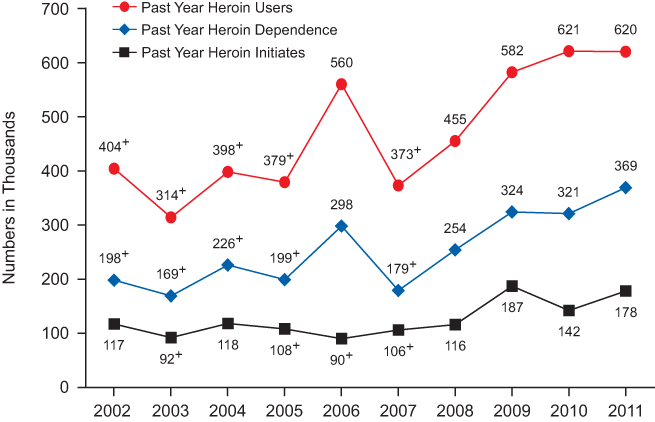Heroin Withdrawal
History of Heroin in America
Opiates were popular in the U. S. during the 1800s, primarily as an elixir for the relief of neurasthenia (a general term referring to melancholia) among young women. The practice of opium smoking was introduced to the U. S. by Chinese immigrants working as laborers on railroads throughout the country. By the turn of the century opium dens had become common across the country.
Following the synthesis from opium to morphine by Friedrich Sertuerner of Germany in 1803, morphine was then synthesized into heroin by Heinrich Dresser in 1895 — and marketed for sale by the Bayer Company in Germany in 1898. Heroin was originally considered a safe alternative for those addicted to morphine. Ironically, in a show of social concern: “… the philanthropic St. James Society mounted a campaign to mail free samples of heroin to morphine addicts.” Heroin addiction began to take hold, mainly in cities of the north.

The Dangers of Opiates
During the 30s, 40s, and 50s, Italian organized crime began to flood cities of the north with heroin smuggled in from France – an operation which came to be known as the “French Connection.” The number of northern urban heroin addicts again soared. During the 70s, concern for heroin addiction among U.S. soldiers in Vietnam led to an inquiry by Congressman Robert Steele (R-CT), which determined as many as 15% of in theater soldiers had become addicted to heroin. Heroin was quickly moved to the top of President Nixon’s list in his war on drugs.
Today, heroin continues to be a major problem across the nation. Joining the import markets of Southeast Asia and the Middle East, is our border neighbor to the south, Mexico; as heroin has piggy backed upon the flow of cocaine smuggled in under the direction of Columbian drug lords. The demand of heroin in the U.S. continues to provide a fertile market for heroin smugglers across the globe (A Social History).
U. S. Heroin Addiction Figures
National findings concerning heroin use compiled by the National Survey on Drug Use and Health from 2002-2011 show an overall increase in heroin use nationwide:
Figure 8.6 Past Year Heroin Use, Heroin Dependence, and Heroin Initiates among Persons Aged 12 or Older: 2002-2011

+ Difference between this estimate and the 2011 estimate is statistically significant at the .05 level.
The report considered first time use (initiates), past year “casual” use, and past year dependent use among those 12 or older. The graph provided (Figure 8.6) clearly shows a more rapid increase from 2007-2011 among all three categories of users. As an explanation for the spike in heroin use, many believe that as the effectiveness of tougher laws and law enforcement strategies intended to curtail illicit pain pill increases, cheaper, easier to obtain heroin becomes a viable alternative (Substance Abuse).
Heroin Dependence
25% of those in developed countries who use heroin become dependent (qtd. Hall W, Doran C, Degenhardt L, et al.). People who have become dependent upon heroin continue its use in spite of the awareness that their addiction is at the root of their problems. Problems which are associated with heroin dependence include: “being arrested or imprisoned, having interpersonal and family problems, catching infectious diseases, and suffering from drug overdoses” (Hall, et al.).
According to the American Psychiatric Association, as presented in the fourth addition of the association’s Diagnostic and Statistical Manual of Mental Disorders (1994), a diagnosis of substance dependence is appropriate when three or more of the following co-occur:
At any time in the same 12-month period:
- Tolerance, as defined by either of the following: need for markedly increased amounts of the substance to achieve intoxication or desired effect markedly diminished effect with continued use of the same amount of the substance;
- withdrawal, as manifested by either of the following: the characteristic withdrawal syndrome for the substance the same (or closely related) substance is taken to relieve or avoid withdrawal symptoms;
- the substance is often taken in larger amounts or over a longer period than was intended;
- there is a persistent desire or unsuccessful efforts to cut down or control substance use;
- a great deal of time is spent in activities necessary to obtain the substance (e.g., visiting multiple doctors, driving long distances), use the substance (e.g., chain smoking), or recover from its effects;
- important social, occupational, or recreational activities are given up or reduced because of substance use;
- the substance use is continued despite knowledge of having a persistent or recurrent physical or psychological problem that is likely to have been caused or exacerbated by the substance (qtd. Hall, et al.).
Heroin Withdrawal Symptoms
With regular use of heroin, the individual develops a tolerance; increased amounts of heroin are necessary to achieve effects that the individual has become physically dependent upon. Immediate cessation or decrease in dosage can lead to withdrawal symptoms which typically commence within 6 hours of the last dose and continue for up to seven days. Heroin withdrawal symptoms include:
- Increased sweating, lacrimation [shedding tears], rhinorrhea [runny nose], urinary frequency
- Diarrhea, abdominal cramps, nausea, vomiting
- Muscle spasm leading to headaches, backaches, e.g. cramps, twitching, arthralgia [joint pain]
- Piloerection [goose bumps], pupillary dilatation, elevated blood pressure, tachycardia [rapid heartbeat]
- Anxiety, irritability, dysphoria [state of unease, general dissatisfaction with life], disturbed sleep, increased cravings for opioids (Guidelines, 31).
While overcoming withdrawal symptoms brought on by dependence is an unpleasant task, it is rarely, if ever, life threatening. Heroin withdrawal can, however: “significantly complicate concomitant medical or psychiatric conditions” (Guidelines, 31).
Heroin detox facilities typically employ a tapering system of drugs (brupenorphine, methadone) to ease withdrawal symptoms and to aid in the completion of withdrawal treatment. But professionals agree; a continued program of recovery is essential if the individual is to live a life free from heroin.
Conclusion
History illustrates that heroin use in America is prone to increase, and rarely follows a continued path of decrease. Recent research shows that at present we are in another substantial rise in heroin use and dependence. Efforts focused to stem the use and distribution of opiate pain killers seems to have driven illicit drug users toward heroin.
Withdrawal from heroin, while extremely uncomfortable, is achievable and easily managed, with the aid of buprenorphine and morphine, by detox facilities nationwide; but withdrawal by itself not an indicator of recovery from heroin addiction. Heroin addiction, on a personal level, can be managed with the help of ongoing rehab programs, and on a national level, by understanding that unless well-intended efforts to curb illicit drug abuse, such as the recent war on opiate pain killers, continue to focus on law creation and enforcement and not the addict himself, the demand for heroin will continue its rise.
References:
“A Social History of America’s Most Popular Drugs”. Frontline. WGBH Educational Foundation, 2013. Web. Retrieved from: http://www.pbs.org/wgbh/pages/frontline/shows/drugs/buyers/socialhistory.html
“Guidelines for the Management of Heroin Withdrawal”. National Drug Strategy: Australia. Commonwealth of Australia. p. 31. Web. http://www.nationaldrugstrategy.gov.au/internet/drugstrategy/publishing.nsf/Content/9011C92D2F6E1FC5CA2575B4001353B6/$File/bupren4.pdf
Hall W, Doran C, Degenhardt L, et al. “Illicit Opiate Abuse”. In: Jamison DT, Breman JG, Measham AR, et al., editors. “Disease Control Priorities in Developing Countries”. 2nd edition. Washington (DC): World Bank; 2006. Chapter 48. Available from: http://www.ncbi.nlm.nih.gov/books/NBK11797/
Substance Abuse and Mental Health Services Administration, Results from the 2011 National Survey on Drug Use and Health: Summary of National Findings, NSDUH Series H-44, HHS Publication No. (SMA) 12-4713. Rockville, MD: Substance Abuse and Mental Health Services Administration, 2012. Retrieved from: http://www.samhsa.gov/data/nsduh/2k11results/nsduhresults2011.htm#Fig8-6